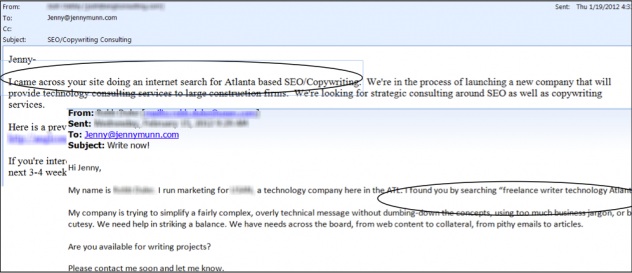I recently heard from an old commercial writing client for whom I hadn’t worked in probably five or six years. She had a small copywriting project, along with a vague “and we’ve got a few other things cooking we might need your help with.†Always a nice treat when old clients surface, but there’s always a bit of a nagging voice that comes with it…
“How come you stopped working with them in the first place?â€
The easy answer? Well, the project you were working on for them ended, you both got busy, and the old “out-of-sight-out-of-mind†thing took over. Never sounds very satisfying, because it points to laziness on my part in the follow-up department. It’s like the natural order of things is that YOU should be contacting them and discovering they have a job for you. NOT them having to reach out to you.
The latter seems to imply that there might very well have been many other commercial freelancing jobs, big and small, you could have done for them in the ensuing years, but you missed out because you weren’t top-of-mind when those gigs came along. And not being top-of-mind also means missing out on possible referrals as well. Sigh.
As confirmation (the self-flagellation now begins in earnest…), she said she was reaching out because the copywriter she’d been using just wasn’t getting it done. Sheesh. And it gets worse. She says, “I need a writer who can write like only you can.â€
You know, like he did on that flurry of work five years back, all of which they loved, and after which, he just vanished. What was I thinking? That that would be all they’d ever need? Turn that knife.
I have a dear friend—and fellow commercial freelancer—here in Atlanta who’s been working with one client steadily for about five years. Seems, every time we talk, their name surfaces as part of the “what’s-on-my-plate-now†conversation. They’ve made her multiple offers over the years to come onboard full-time. But, she’s resisted. Hey, why buy the cow, etc., etc.
She gets constant work from them because she knows their business inside and out, is a great writer, incredibly thorough, knows PowerPoint like the back of her hand (along with several other programs; no, you don’t have to be so technically inclined to succeed as a commercial freelancer, but it doesn’t hurt). In short, she’s incredibly capable and versatile.
So, when the workload with a client is steady and ongoing, as it is with hers, it’s easy to not lose touch. But clients like that (i.e., providing a virtually unbroken streak of work) are most definitely the exception, not the rule, in this commercial copywriting business of ours.
Now, I’ve been pretty good at keeping in touch with most of my clients over the years, but if I’m going to be honest here—and Exhibit A above makes it hard to come to any other conclusion—there are a handful of clients who would have been turning to me far more often over the past years had I done a better job of keeping in touch.
Recently, thanks to that blast-from-the-past client call, I reached out to a bunch of those “fell-through-the-crackers.†While nothing’s come of it yet, I’m back on their radar, with an OK to check back in on X date, so that’s all good.
Yes, as we all know, there are a lot of reasons that have nothing to do with us, why we might stop working with a client: company goes out of business; our contact leaves for another company, and the new one has their favorite writer; company hires an in-house writer (or just dumps the writing off on that overworked admin), etc.
But, that’s not the whole story, and we all know it. As the marketing truism reminds (uncomfortably, perhaps?), “It’s far easier to get more work from an existing client than to land a new one.â€
Have you had an old client get back in touch after several years, making you realize you’d done a sorry job of regular follow-up?
How do you ensure good clients, even those without steady, ongoing work, keep you “top of mind†for when they do need a writer?
Have you had a steady client that’s hired you for at least 3 years? If so, what do you do (besides write really well) that keeps them coming back?
Have you just thought of a few clients you lost touch with? And what are you going to do about it? 😉
Want to be a guest blogger on TWFW Blog? I welcome your contribution to the Well-Fed writing community! Check out the guidelines here.



